
- Science news
- Open science policy
- Open Access to science papers will be default by 2020, say European ministers
Open Access to science papers will be default by 2020, say European ministers
By Emily Barker, Communications Strategist at Frontiers
There was a breakthrough for open-access publishing on Friday 27 May, as EU research ministers published a commitment to make open access to scientific publications as the default option by 2020.
“It’s a major step forward,” said EU Research Commissioner Carlos Moedas. “You cannot stop the movement. Publishers will have to change their business models.”
What does this mean for science publishing?
The open-access movement isn’t new. Already over 30% of peer-reviewed papers are now published in some form of Open Access, which means the tipping point for disruption has already come and gone. Frontiers, born digital in 2007, was the first open-access publisher to develop its own publishing platform that has not only revolutionized the peer-review process by making it more transparent, but has also helped advance research by publishing sound science rapidly while making it openly accessible to all.
Unlike traditional publishing, the costs for open-access publishers are far lower as they have no costs for paper or printing distribution. However, that does not mean they are free. Open-access journals need editors and editorial support staff to maintain quality and a complex, scalable technological backbone for storage and to ensure the research they publish is always accessible. Still compared to high cost of subscriptions, which results in approximately $7,000 for each subscription article published, article processing charges typically attached to open-access articles are much lower – averaging around $2,000.
Most importantly, open-access publishers are innovative. Frontiers has created a series of digital services that are impacting the way scholarly publishing is evolving, including: a digital editorial office, author and editor profiles, article level metrics, author impact metrics, an interactive peer-review forum and the tools that drive the Frontiers tiering system. These and more, were all created in-house.
Open-access publishing will also help bring more science into the spotlight. So-called top journals reject as many of 90-95% of the manuscripts they receive.
In traditional journals scientists are forced to make a choice – either publish in a lower impact journal and get a fast, quite likely positive decision, or accept a high risk of rejection in a high impact journal and prepare for an excruciating review and rejection cascade from one journal to another.
However, Frontiers found that there was no correlation between rejection and impact. In fact, many journals with high rejection rates have low impact factors and many journals with low rejection rates have impact factors that are higher than the bulk of journals with rejection rates of 70-80%. Clearly, selecting “winners” is hard and the belief that obtaining a high impact factor simply requires high rejection rates is false.
Frontiers citations rates are amongst the very highest when compared to journals in the same categories with low rejection rates. In Frontiers’ impact-neutral, specialist review process, editors and reviewers are asked to improve the paper unless it has irreparable errors. Reviewers are not asked to judge the “importance” and “novelty”.
For the first time, it is becoming possible for authors to publish their work rapidly and gain the impact they deserve without jumping through the hoops of traditional review.
The new EU commitment is not a law, and therefore it is up to the individual EU member states to implement it. However, as Carlos Moedas said this could be “life-changing” for Europe.
The decision was taken during a meeting of the Competitiveness Council in Brussels on 26-27 May.






